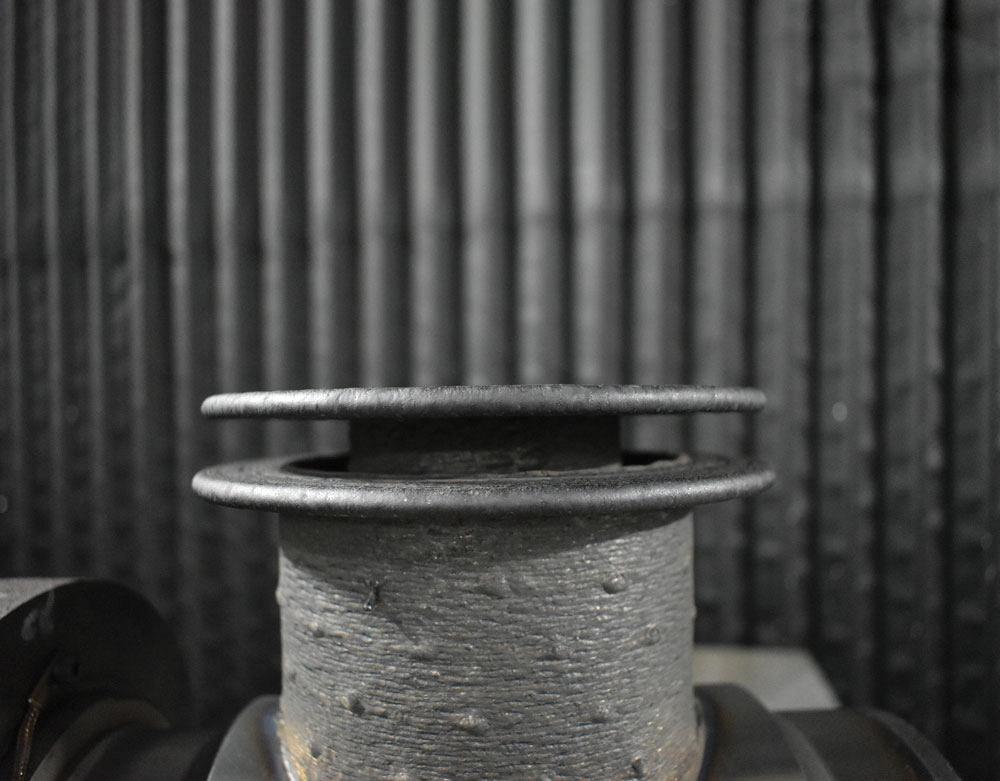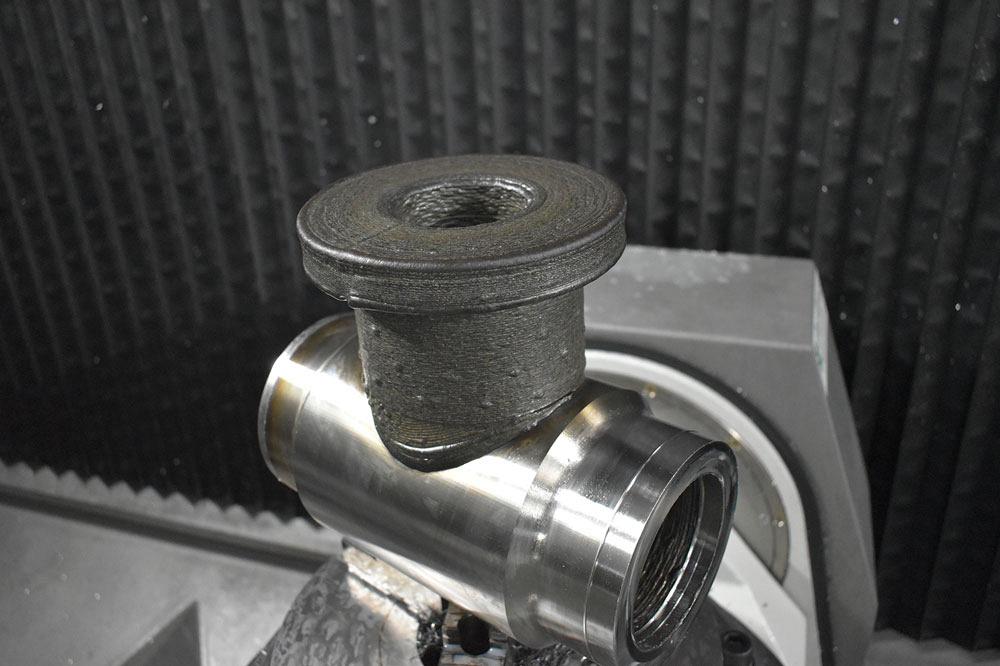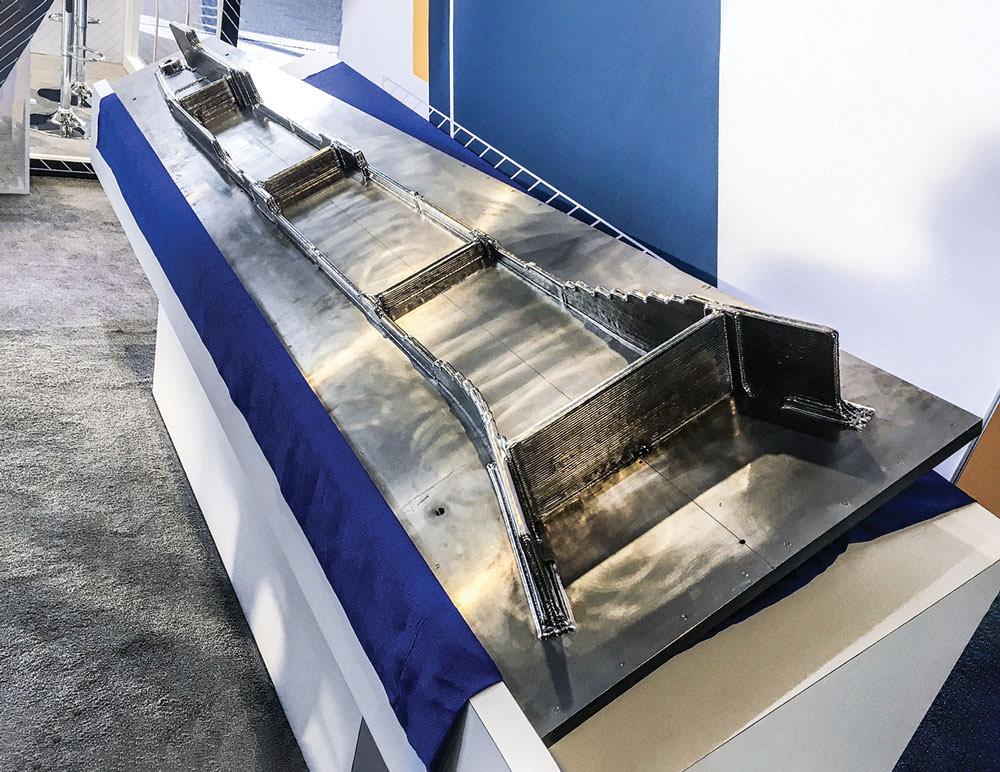Managing Director
- FMA
- The Fabricator
- FABTECH
- Canadian Metalworking
The progression of directed energy deposition
This form of additive manufacturing deposits material and heats it at the melting point simultaneously
- By Alan Levine and David Bourdages
- January 31, 2024
- Article
- Metalworking

Directed energy deposition process allows the production of hollow structures. The ability to orient the part during the additive process enables the creation of structures with overhang without the need to create support structures. Oak Ridge National Laboratory
Directed energy deposition (DED) encompasses several classes of additive manufacturing (AM) processes. For clarity, it can be compared to another well-known process, selected laser melting (SLM). The SLM process deposits thin layers of metal powder and uses a laser to selectively melt the powder. Repeating this process over and over makes it possible to build complex geometry with intricate designs. The DED process deposits the material and heats it at the melting point simultaneously. The arc welding process is part of the DED family.
Other well-known DED processes include laser with powder, laser with wire, and electro-beam with wire.
DED processes can be used with different machine types, including additive machines, hybrid machines capable of additive processes as well as subtractive processes like milling and turning, conventional machines that are retrofitted with deposition capability to become hybrid, and on robotic-delivery systems.
Initially, R&D of DED processes was performed by machine manufacturers, research centres, and universities. The promise of this new technology created a lot of excitement tempered by a degree of disappointment because it was not easy to master and required a lot of knowledge, even more than conventional machining.
Some of the challenges in AM include managing build recipes and transient thermal conditions and enabling predictable material deposition through careful machine control/toolpath planning.
These challenges are being met through continued development along with practical experiences. In addition to some niche applications, general industry has now learned how to fully exploit DED processes.
As the common base of AM knowledge continues to grow worldwide and begins to mature, new applications for the DED process are being found and the technology is becoming successfully applied in many ways. Partners and customers are making good use of this new technology through collaborative applications.
Collaborative Success
Some years ago, a manufacturer approached OPEN MIND Technologies with the need to build rotationally symmetric profiles with variations in the wall thicknesses. The goal was to replace roll-formed sheet metal parts that were welded together to make something similar to a jacket.
OPEN MIND’s proposal was to introduce a new technique where the additive process would behave like a 3-axis turning toolpath and to produce the part on a 5-axis machine. Using a multiaxis turning toolpath directed the flow of material on the previously built material.
But, because the starting and stopping of the additive process can induce defects such as porosity in the structure, the company developed a continuous, uninterrupted process that handles the side walls and the variable thicknesses. The initial usage of this approach showed great potential, and the subsequent analysis done by OPEN MIND’s partner, Oak Ridge National Laboratory, showed that this process offered additional advantages in terms of material density, mechanical properties, and grain structure.

This completed Hot Isostatic Pressing (HIP) container is ready to be packed with powder. Oak Ridge National Laboratory
From a software and programming standpoint, DED applications are, technically speaking, often more complex than SLM applications. For most SLM applications, simple slicing software will generally do the job. However, 2D slicing will typically not fulfill the requirements for a DED process, with the exception being for basic 2D applications.
For advanced work, there are benefits to using a CAD/CAM package that provides the freedom to use existing CAD tools and milling strategies and apply them to the additive process along with built-in automation. Because almost every DED application is unique and requires a special approach, the user can develop the processes required for each use case.
Aerospace AM Example
One good example of this was provided by a customer developing a process to build structural parts for the aerospace industry. Because of the nature of the parts and the need to control every aspect of the additive process, the manufacturer applied the CAD tools to create the additive patterns.
Afterward, combining automatic selection and CAM strategies, it created a unique process, which avoided the distortion of the part during the build process.
Also in this case, the additive process was compared to the production of large titanium forgings that conventionally required extensive material removal. Because titanium is a limited resource, finding a manufacturing option using less raw material is very beneficial and more economical.
When manufacturing functionally graded materials and composite metal structures, the goal is to produce a part with non-uniform material composition where some areas of the part are made of different alloys to address different needs, whether they are physical, mechanical, or chemical.
To generate such a part, the software needs to know where the change should occur and what technology should be applied. Once this is known, the technology information is updated along the path to create the part.
Another application for modifying technology parameters during a build is the process behaviour. For instance, some processes might require different technological parameters at the beginning or end of an additive stroke, or while adding material to the left or to the right. Storing this information in the CAD program and retrieving it with CAM allows manufacturers to precisely control the technological condition of their process.
Another interesting and creative way to apply the DED process is to create Hot Isostatic Pressing (HIP) containers. Basically, the HIP technique uses the DED process to create a hollow container that will be packed with powder. Then, at a high temperature (ranging from 482 to 1,320 degrees C), high pressure (between 50.7 and 310 MPa) is applied to compact the powder, creating a fully dense material.
The additively manufactured container is subsequently machined away, leaving only the high-quality metallic part. This “cast” part is then machined in a secondary process to attain the desired shape and quality.

Using additive manufacturing, large aerostructure component production can reduce raw material usage by approximately 80 per cent, making efficient use of raw materials. GKN Aerospace
While we have yet to fully realize the benefits of the DED processes, the technology is rapidly progressing. DED successes are occurring in commercial applications today, and the future of this technology is very promising, especially when manufacturers continue collaborative approaches to further its development.
David Bourdages is product manager and Alan Levine is managing director for OPEN MIND Technologies USA, 1492 Highland Ave., Unit 3, Needham, Mass. 02492, 888-516-1232, www.openmind-tech.com.
About the Authors
subscribe now


Keep up to date with the latest news, events, and technology for all things metal from our pair of monthly magazines written specifically for Canadian manufacturers!
Start Your Free Subscription- Trending Articles
Automating additive manufacturing

Sustainability Analyzer Tool helps users measure and reduce carbon footprint

CTMA launches another round of Career-Ready program

Sandvik Coromant hosts workforce development event empowering young women in manufacturing

GF Machining Solutions names managing director and head of market region North and Central Americas

- Industry Events
MME Winnipeg
- April 30, 2024
- Winnipeg, ON Canada
CTMA Economic Uncertainty: Helping You Navigate Windsor Seminar
- April 30, 2024
- Windsor, ON Canada
CTMA Economic Uncertainty: Helping You Navigate Kitchener Seminar
- May 2, 2024
- Kitchener, ON Canada
Automate 2024
- May 6 - 9, 2024
- Chicago, IL
ANCA Open House
- May 7 - 8, 2024
- Wixom, MI















